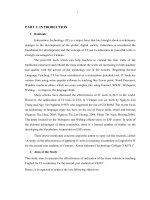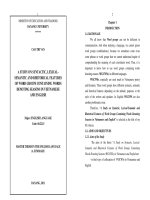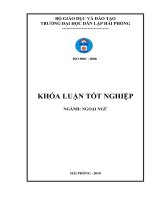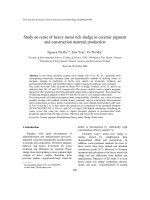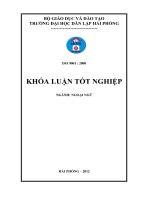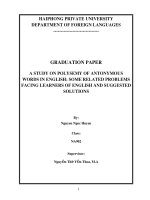Study on kinetics of electro-optical and photoluminescent processes in nanostructured transition metal (W, Mo) oxide-based thin films
Bạn đang xem bản rút gọn của tài liệu. Xem và tải ngay bản đầy đủ của tài liệu tại đây (1.59 MB, 91 trang )
Đại học Quốc Gia Hà Nội
trờng Đại học Công Nghệ
Lê Hà Chi
Nghiên cứu Động học các quá trình
biến đổi điện - quang - quang tử của
màng mỏng vật liệu ôxít kim loại
chuyển tiếp (W, Mo) cấu trúc nanô
Ngành: Khoa học và công nghệ nano
Mã số:
Luận văn thạc sĩ
Ngời hớng dẫn khoa học: PGS. TS. Nguyễn Năng Định
Hà Nội - 2005
TABLE OF CONTENTS
Preface 1
Chapter 1 Overview of transition metal (W, Mo) oxides and their electrochromic
properties 2
1.1 Introduction of transition metal 2
1.2 Bulk crystalline structures of tungsten oxide and molybdenum oxide [4] 4
1.3 Properties of tungsten oxide and molybdenum oxide 7
1.4 Applications for electrochromic materials 11
Chapter 2 Photoluminescent properties of nanocomposite materials 20
2.2 Fluorescence and phosphorescence (photoluminescence) [20] 20
2.2 Physics of nanostructured materials [7] 23
2.3 Enhance photoluminescent performance of nano-composite materials 33
Chapter 3 Experiments 39
3.2 Preparation by electrochemical method 39
3.2 Preparation by thermal oxidation method 45
3.3 Study on morphology and structure of the films 48
Chapter 4 Kinetics of electro-optical transformation processes of nanostructured
WO
3
-based thin film 55
4.1 Ion intercalation/extraction studied by electrochemical techniques 55
4.2 Electro-optical properties of WO
3
-based electrochromic device studied in-situ
by Optics Multi-canal Analyzer 63
Chapter 5 Study on photoluminescent transformation processes of
nanostructured MoO
3
-based nanocomposite 68
5.2 Preparation of PVK+nc-MoO
3
nanocomposite 68
5.3 Molecular bonding studied by Raman spectroscopy 69
5.3 Photoluminescent properties studied by FL 3 - 22 Spectrometer 75
5.4 I-V characteristics studied by electrochemical technique 79
Conclusion 83
References 85
- 1 -
1
Preface
The purpose of this work is to prepare nanostructured transition metal (W, Mo) oxide -
based thin films and study their kinetics of electro-optical and photoluminesent
processes. It is known that electrochromic materials have been found many interests
with the respect not only to the fundamental studies, but also to the application scopes,
such as solar energy management, sensors and display devices [1,3]. Among these
electrochromic materials, tungsten oxide films are by far the most extensively studied.
WO
3
is a wide band gap semiconductor with Eg ≈ 3.2 eV, it thus transparent in the
visible light range [3].
Electrochromic tungsten oxide films can be prepared by a variety of different
techniques such as physical vapor [2] and chemical vapor deposition [14,29],
electrochemical deposition [13,34], sol - gel [25], etc. The electrochemical deposition
is expected to be one of the most economical methods for making a large-area film as
well as automatically controlling the film growth. However, these transmittances as
well as the durability of the films were still limited for practical use. The aim of this
work is to improve electrochromic properties of WO
3
thin films deposited by
electrochemical method. The morphology, electrochemical and optical properties
concerning with electrochromic performance of the films are also discussed.
In addition, we tried to design a new device based on nanostructured MoO
3
thin film
and poly-(N-vinyl carbazole) according to typical OLED sandwich structure. The
enhanced photoluminescent performance was investigated and I-V characteristics was
also studied.
- 2 -
2
Chapter 1
Overview of transition metal (W, Mo) oxides and
their electrochromic properties
1.1 Introduction of transition metal
In chemistry, the term transition metal (sometimes also called a transition element) has
two possible meanings:
It commonly refers to any element in the d-block of the periodic table, including
zinc and scandium. This corresponds exactly to periodic table groups 3 to 12
inclusive.
More strictly, it can refer to those elements which form at least one ion with a
partially filled d shell of electrons. This is exactly the d-block with zinc and
scandium excluded.
The first has the attraction of apparent simplicity and is the traditional usage. However,
many interesting properties of the transition elements as a group are the result of their
ability to contribute valence electrons from s orbitals before d orbitals, a property
which all members of the d-block except zinc and scandium share, so the more
restricted definition is in many contexts the more useful. The d orbitals are contributed
after the s orbitals because once the d orbital begins to fill its electrons move closer to
the nucleus, leaving the s electrons as the outermost.
The 40 transition metals: The (loosely defined) transition metals are the forty
chemical elements 21 to 30, 39 to 48, 71 to 80, and 103 to 112. The name transition
comes from their position in the periodic table of elements. In each of the four periods
in which they occur, these elements represent the successive addition of electrons to
the d atomic orbitals of the atoms. In this way, the transition metals represent the
transition between group 2 elements and group 13 elements.
- 3 -
3
Table 1.1. The periodic table of the 40 transition metals
Group
3 (III
B)
4 (IV
B)
5 (V
B)
6 (VI
B)
7 (VII
B)
8 (VIII
B)
9 (VIII
B)
10 (VIII
B)
11 (I
B)
12 (II
B)
Period
4
Sc 21
Ti 22
V 23
Cr 24
Mn 25
Fe 26
Co 27
Ni 28
Cu 29
Zn 30
Period
5
Y 39
Zr 40
Nb
41
Mo 42
Tc 43
Ru 44
Rh 45
Pd 46
Ag 47
Cd 48
Period
6
Lu 71
Hf 72
Ta 73
W 74
Re 75
Os 76
Ir 77
Pt 78
Au 79
Hg 80
Period
7
Lr 103
Rf
104
Db
105
Sg
106
Bh 107
Hs 108
Mt 109
Ds 110
Rg
111
Uub
112
Electronic configuration:
W: [Xe]6s
2
4f
14
5d
4
Mo: [Kr]5s
1
4d
5
Variable oxidation states: The transition metals show a wide variety of oxidation
states because their partially filled d orbitals can accept or donate electrons in chemical
reactions. A transition element like tungsten or molybdenum has roughly linear
increasing ionisation enthalpies throughout its s and d orbitals, due to the close energy
difference between the 5d and 6s (W) or 4d and 5s (Mo) orbitals. Transition metal ions
are therefore commonly found in very high states. The oxidation states found in
compounds of W and Mo are changed from 2 to 6.
Properties with respect to the stability of oxidation states:
Higher oxidation state ions become less stable across the period.
Ions in higher oxidation states tend to make good oxidizing agents, whereas
elements in low oxidation states become reducing agents.
The 2+ ions across the period start as strong reducing agents, and become more
stable.
- 4 -
4
The 3+ ions start stable and become more oxidizing across the period.
1.2 Bulk crystalline structures of tungsten oxide and molybdenum oxide [4]
1.2.1 Crystal structures of tungsten oxide and molybdenum oxide
For Mo oxide, just as for W oxide, the basic structural element is an octahedron with a
metal atom at the center and oxygen atoms at the corners, Figure 1.1. Deviations from
the ideal cubic perovskite-like structure correspond to antiferroelectric displacements
of W atoms and to mutual rotations of oxygen octahedra. The magnitude of the
distortion depends on the temperature, which is in agreement with the behavior of most
perovskites, and pure WO
3
single crystals go through structural transformations
according to the sequence tetragonal → orthorhombic → monoclinic → triclinic →
monoclinic as the temperature is lowered from 900 to -189
o
C. Tungsten oxide has a
tendency to form substoichiometric phases containing edge-sharing octahedra.
Figure 1.1. Schematic illustrating a corner-sharing arrangement of octahedra
in a W oxide or Mo oxide crystal.
The crystal structure has been studied by high-resolution electron microscopy, and
extended defects characterized by crystallographic shear planes, pentagonal
(W, Mo) atoms
Oxygen atoms
- 5 -
5
bipyramidal columns, and hexagonal tunnels have been identified. Figure 1.2
demonstrates arrangements of WO
6
octahedra surround large defects with hexagonal
and pentagonal cross-sections.
Figure 1.2. Interpretation of high-resolution transmission electron micrographs
for two crystals of WO
3-z
with different stoichiometry.
Hexagonal WO
3
phases are of particular relevance to electrochromism, as will be
mentioned later. Hexagonal phases are characterized by a one-dimensional tunnel
structure extending through the material. An even more open pyrochlore structure of
WO
3
, with a three-dimensional tunnel structure, was discovered recently. It contains
some W and O vacancies as well as H
3
O
+
for charge neutrality.
1.2.2 Crystal structures of (W, Mo) bronzes and ion intercalated (W, Mo) oxide
Tungsten bronzes can be represented as M
x
WO
3
with M being an atom from the first
column in the Periodic Table. Their crystal structure depends on the type and density of
the species added to the WO
3
host. M
x
WO
3
bronzes with 0 ≤ x ≤ 1 and M = Li, Na, K,
Rb, and Cs (with ionic radii 0.060, 0.095, 0.133, 0.148 and 0.169 nm, respectively).
The phase domains are approximate only. Cubic (perovskite) phases are found within a
- 6 -
6
range that is displaced towards increased x value for increased ionic radii. Such a
structure does not exist in pure WO
3
but it is possible to extrapolate a lattice parameter
for a hypothetical material. Tetragonal phases are found at low to intermediate x values
for Li
x
WO
3
and Na
x
WO
3
and at intermediate x values for K
x
WO
3
. Hexagonal phases
occur for small incorporation of large ions: K
x
WO
3
, Cs
x
WO
3
, In
x
WO
3
and Li
x
WO
3
. In
case of H
x
WO
3
, the hydrogens are thought to be statistically attached to the oxygens as
hydroxyl groups, so the material may be adequately represented as WO
3-x
(OH)
x
. There
are reports about an orthorhombic phase at x = 0.1, tetragonal phases for x = 0.23 and x
= 0.33, and a cubic phase for x = 0.5. Modifications of the crystalline structure during
Li
+
intercalation/extraction are of particular concern for electrochromic devices.
Figure 1.3. Tungsten trioxide crystalline structure with ion M
+
(H
+
, Li
+
, Na
+
) intercalation
have perovskite-like atomic configurations based on corner-sharing WO
6
,MoO
6
octahedra.
It seen from Figure 1.3 that ion M
+
intercalation makes the sample transform according
to monoclinic → tetragonal → cubic with intermediate mixed phases. The WO
6
octahedra are shown as well as the sites available for ion intercalation. From an
- M
- W, Mo
- O
- 7 -
7
inspection of the structures, it is reasonable to expect that only small ions (H
+
, Li
+
,
Na
+
) can be accommodated in the cubic configuration.
The open crystal structures of Mo oxide and its hydrates make these materials excellent
as intercalation hosts for H
+
, Li
+
, and other ions. K
0.3
MoO
3
can serve as a host for
cyclic Li intercalation/deintercalation. It is possible to prepare Li
x
MoO
2
and Na
x
MoO
2
with x up to ~ 1. The materials can serve as intercalation hosts and are of interest in
battery technology.
1.3 Properties of tungsten oxide and molybdenum oxide
Molybdenum oxide films show pronounced electrochromism and have many properties
in similar with tungsten oxide. The discussion below covers the optical properties, the
electrical properties and electrochromism of these oxide films in common.
1.3.1 Optical properties [4, 14]
WO
3
crystals have an average refractive index for white light of 2.5. Color changes
appear in WO
3-z
when z is increased, as investigated by Glemser and Sauer.
Intercalation of alkali ions, so that tungsten oxide bronzes are created, also leads to the
development of colors. The colors are indicative of a strongly wavelength dependent
reflectance. Diffuse spectral reflectance of Na
x
WO
3
in the luminous and near-infrared
spectral range was reported by Brown and Banks with a reflectance maximum at ~ 0.5
μm for x < 0.2 and a reflectance minimum at ~ 0.5 to ~ 0.7 μm for x ≥ 0.2. In the latter
samples, there is high reflectance beyond a certain wavelength that shifts towards
smaller values as the Na content is increased. At 0.2 < x < 0.5, the reflectance lies
primarily in the infrared range, and the moderately high reflectance of blue light
appears in the visible range. At 0.2 < x < 0.5, there is high reflectance in the long-
wavelength part of the luminous spectrum, and consequently the visible appearance is
reddish or yellowish.
- 8 -
8
In addition, Faughnan et al. studied the optical absorption of an evaporated WO
3
film,
and proposed a coloration mechanism as follows [31]:
Me
n+
(B) + Me
n+
(A) + e
-
Me
n+
(B) + Me
(n-1)+
(A) (1.1)
Me
(n-1)+
(A) + Me
n+
(B) + h Me
n+
(A) + Me
(n-1)+
(B) (1.2)
And the polaron absorption spectrum is given by:
pol
()
-1
exp(ħ- 4U
p
)
2
/ 8 U
p
ħ
ph
(1.3)
1.3.2 Electrical properties
The electrical conduction of W-oxide-based materials poses long-standing problems
[4], and defects in the WO
3
lattice play a decisive role for the physical properties.
According to Mott [4], the conductivity in tungsten bronzes have three possibilities:
(i) Andreson localization in the conduction band as a consequence of strong
scattering from the intercalated ions,
(ii) formation of an impurity band and localization due to disorder for x > 0.2,
and
(iii) splitting-off of an impurity band as a consequence of electron correlation
and Anderson localization in a pseudogap.
However recent high-resolution electron spectroscopic data by Hill and Egdell and
Hollinger et al. showed that the metal-nometal transition at x ≈ 0.2 was due to
localization in a pseudogap between an impurity band and the WO
3
conduction band,
which is in agreement with mechanism (iii).This contention is supported by a
numerical analysis by Koslowski and Von Niessen. The nature of the pseudogap has
been discussed; specifically Hollinger et al. suggested a Hubbard gap due to long-range
electron interaction, whereas Davies and Franz brought attention to the possible
- 9 -
9
manifestations of a Coulomb gap due to long-range electron interaction. Hill and
Egdell argued in favor of localized small polarons.
1.3.3 Electro-optical transformation processes (Electrochromism)
The term "electrochromism" was introduced by Platt [4] to represent electric-field-
dependent changes in optical absorption spectra of organic dye molecules dissolved in
organic solvents. Then, electrochromic materials have been a subject of wide interest
with the respect to both fundamental studies of the physical phenomenon itself and
their possible application in solar energy management, display devices etc.
An electrochromic material is able to change its optical properties when a
voltage is applied across it. The optical properties should be reversible, i.e., the
original state should be recoverable if the polarity of the voltage is changed.
Electrochromism is a phenomenon in which the color of a material changes on
application of a voltage. Electrochromism is well-known in numerous in organic
and inorganic substances.
Table 1.2 summarizes a number of key properties of the electrochromic oxides. The
first column indicates the nominal composition of the oxide. The second and the third
column in the table list the overall optical properties. Only some of the oxides
mentioned above can be fully transparent to visible light, notably the oxides based on
Ti, Ni, Nb, Mo, Ta, W and Ir. Essentially all of the electrochromic oxides are
constructed from one type of building blocks, MeO
6
octahedra with a central transition
metal (Me) atom surrounded by six oxygen atoms. It was stressed that the
electrochromic oxide films must be permeable to ions and must show some electrical
conductivity. The ions can move and reside in the spaces between the MeO
6
octahedra.
- 10 -
10
Table 1.2 Summary of key features for the main electrochromic oxides,
showing oxide type, whether the coloration is cathodic C or anodic A,
whether full transparency can be achieved (yes = Y; no = N) [4]
Oxide type
Coloration
Full transparency
TiO
2
C
Y
V
2
O
5
C/A
N
Cr
2
O
3
A
N
MnO
2
A
N
FeO
2
A
N
CoO
2
A
N
NiO
2
A
Y
Nb
2
O
5
C
Y
MoO
3
C
Y
Ta
2
O
5
C
Y
WO
3
C
Y
IrO
2
A
Y
Among these oxides, Tungsten oxide films is by far the most extensively studied
electrochromic material. The tungsten trioxide structure is octahedral with six oxygen
atoms and one tungsten atom. WO
3
is transparent in the visible light range. When
electrons and protons (or alkaline metal ions) are injected into WO
3
, its structure
- 11 -
11
changes to perovskite. The electric charge of tungsten is changed from 6+ to 5+. The
color of tungsten oxide then changes from transparent to blue. When the injected
electrons and ions are removed from WO
3
, the color of WO
3
changes from blue to
transparent.
1.4 Applications for electrochromic materials
1.4.1 Electrochromic devices [1, 3]
Figure 1.4. A prototype electrochromic device
Electrochromism, the reversible change in optical properties when a material is
electrochemically oxidized or reduced, has a long history of fundamental and practical
interest. A five-layer prototype electrochromic device, see Figure 1.4, introduces basic
design concepts and types of materials. In principle an electrochromic device consists
of a transparent electrode of transition metal oxide (WO
3
, MoO
3
thin film) deposited
on a conductive glass (ITO, ATO,…), ion conductor either a thin film or a polymeric
laminate material; it should be a good conductor for small ions such as H
+
or Li
+
and a
counter electrode. By applying a voltage between the outer layers, ions can be shuttled
into and out of the electrochromic films whose optical properties are changed, thereby
modifying the overall optical performance of the device. The principles of four
- 12 -
12
different applications of electrochromic devices are shown in Figure 1.5 [6]. Arrows
indicate incoming and outgoing electromagnetic radiation and the thickness of the
arrow signifies radiation intensity.
Figure 1.5. The principles of four different applications of electrochromic devices.
1.4.2 Smart window [5]
Electrochromic windows have fueled much of the recent interest in electrochromism.
Such windows promise actively controlled, continuously tunable light transmission.
Computer modeling of energy flows in buildings equipped with windows having this
capability show significant energy savings in some locations and seasons. Then it is
possible, with the new technology for 'smart windows ' and 'intelligent' glasses to let
the window have variable transmittance. It is possible to stop at any intermediate
transmittance level, i.e., the films have a „memory‟ so that the voltage needs to be
- 13 -
13
applied only for altering the optical properties. The time for going between bleached
and colored state depends on the size of the window, and anything between ten seconds
and a few minutes can be regarded as typical. These times can be compared with the
time it takes for the eye to accommodate.
Figure 1.6. Design of smart window
The general reaction in electrochromic windows may be written as [5]:
EC
n
+ yCE
m
↔ EC
n-a
+ yCE
m+(a/y)
(1.4)
bleached colored
In complementary electrochromic windows, CE is an anodically coloring
electrochromic layer, thus reinforcing the overall coloration process. For generality, n
and m represent the oxidation states of the electrochromic moieties in the bleached
- 14 -
14
state, while y provides for the fact that EC and CE can be present in any stoichiometric
ratio. Thin film electrodes require insertion/extraction of ions during redox cycling.
Figure 1.7. The transmittance change between coloured and bleached state
of the electrochromic windows in comparison with the eye sensitivity.
(a)
(b)
Figure 1.8. (a) Bleached state and (b) Coloured state of the electrochromic windows.
- 15 -
15
The major function of electrochromic windows so-called 'smart windows' is to control
the flow of light and heat passing the building glazing and the glazing of vehicles. In
future, the electrochromic windows will be massively applied for energy saving in
buildings and cars in order to prevent the indoor heating by sun.
Figure 1.9. Electrochromic systems using in car.
Figure 1.10. 'Intelligent' automobile glasses with (a) Bleached state and (b) Coloured state
- 16 -
16
1.4.3 Gas sensors [27]
The regulation, measurement and control of noxious gases in the atmosphere play
important role to the environmental protection of most countries. It is well known that
nitrogen oxide is one of the most polluting and toxic components. Its detection is
therefore of interest in air quality control, combustion processes and engine emissions.
In the latter two cases nitrogen monoxide is then oxidized in the atmosphere to
nitrogen dioxide; this latter in turn being converted into organic nitrates and nitrites and
presumably into nitric acid by means of chemical and photochemical reactions in the
atmosphere polluted by organic substances.
According to the work [27], WO
3
-based sensors exhibit high sensitivity values and are
also able to detect very low concentration of NO. The detection is carried out by
measurements of electrical conductance changes due to gases chemisorbed onto the
material surface. To prepare WO
3
-based sensors, tungsten oxide were deposited onto 1-
mm rough alumina substrates 5 x 7 mm
2
. A four-point Van der Pauw method was used
to measure the electrical properties of the films. The sensitivity to NO oxidizing gas
was defined as S=(R
g
-R
a
)/ Ra, where Ra is the electrical resistance in air and Rg is the
electrical resistance after exposure to NO.
Usually, in stationary conditions nitrogen oxide acts as oxidizing gas towards the most
of n-type metal oxide semiconductors. Therefore, as expected, it was observed that the
injection of nitrogen oxide leads to a drastic increase in resistivity. The electrical
resistance variations of the same film exposed to different step of NO concentrations in
dry air is reported in Figure 1.11. Also in this case, the resistance of the film reached its
starting value after the test gas is shut off and this proves that the absorption process is
reversible. Furthermore, the advantage in using WO
3
sensors is not only applied for
detection in the range of ppm concentration but also related to the fast response and
recovery times.
- 17 -
17
Figure 1.11. Response of a WO
3
sample at increasing steps of NO concentration.
According to the interaction mechanism of the NO molecules with the surface of the
material, as in the most of metal oxide sensors, the NO gas in presence of oxygen of
the air tends to oxides in NO
2
. This NO
2
can be adsorbed or can interact with the
oxygen adsorbed onto the sensors surface according to the following reactions:
NO
2g
+ e
-
→ NO
2
-
(1.5)
NO
2g
+ O
2
-
+ 2e
-
→ NO
2
-
+ 2O
-
(1.6)
Simultaneously, the NO gas that has not reacted with the oxygen of the air can be
adsorbed on the oxide surface and reacts with the oxygen adsorbed. In this case the
involved reaction will be:
NO
2g
+ e
-
→ NO
2
-
(1.7)
These reactions reduce the electron concentration and therefore an increase of the
electrical resistance occurs. The adsorbed ions NO
2
-
are desorbed as NO
2
gas when NO
flow is stopped and consequently in this process a recovery of the initial conditions
take place.
- 18 -
18
1.4.4 Thin film batteries [17, 33]
The similar features of electrochromic devices and rechargeable thin film batteries
concern the material properties, structure of the layers, kinetics of switching
(charge/discharge cycles), energy and power density and electrical parameters but also
differences between them will be comprehensively discussed in [17]. As discussed, one
of the most important type of electrochromic devices is a battery-like window,
essentially a transparent rechargeable thin film battery (rocking-chair type) consisting
of a pair of complementary intercalation layers, separated by an ion-conducting
polymer electrolyte and contacted by transparent conducting oxide electrodes on glass.
At least one of those intercalation electrodes must show coloration by anodic oxidation
or cathodic reduction. The battery-like electrochromic device is shown in Figure 1.12.
Figure 1.12. Electrochemical reactions, electron and ion exchange processes in an
electrochromic device (TCO: transparent conducting electrodes, IC: ion conducting polymer
film with KA: dissolved salt, EC1 and EC2: complementary intercalation layers,
one or both have to be electrochromic layers, CU: control unit).
The similar features of electrochromic devices and rechargeable thin film batteries
concern the material properties (intercalation capability), structure of the layers,
kinetics and mechanism of switching (charge/discharge cycles), energy and power
- 19 -
19
density, extended open circuit memory and other electrochemical parameters, for
example, a high exchange current density. High electron transfer rates between
collector electrodes and active layers, a good electron and ion conductivity within in
the active layers and high ion conductivity of the polymer electrolyte present much
analogous features too.
Essential differences between electrochromic devices and thin film batteries concern
the charge density in relation to the efficiency, the open circuit voltage V
O
, the
requirements in regard to porosity, the cycling life time, the discharge depth and the
electrical and optical properties of collector electrodes and active layers. A viable
electrochromic smart window must for example exhibit a cycling life time >10
5
cycles
corresponding to an operation life at 10–20 years. In comparison, the cycle lifetime of
the batteries is often < 1000 cycles. A stringent requirement concerns the charge and
discharge depth of electrochromic devices. These must be very deep to achieve a high
range for the change of optical density, a high transmittance in the bleached state and
low transmittance in the darkened state. For batteries, an overload and a deep discharge
is bad and must be avoided, since that often leads to the decrease of cycle life and
irreversible changes of the structure of the host substances. Compared to batteries, the
requirements of charge densities for electrochromic windows are quite severe, too. A
high coloration efficiency and a high speed of the switching cycles require a low
charge density for a high response in the optical density. Batteries must show a high
charge density. On the other hand, the electrochromic devices must exhibit a low open
circuit voltage (V
O
< 1.2 V) but V
O
should be >2 V for batteries. There are the weak
points of the electrochromic devices that should be overcome in the future.
- 20 -
20
Chapter 2
Photoluminescent properties of nanocomposite materials
2.1 Fluorescence and phosphorescence (photoluminescence) [20]
Luminescence is the emission of light by a substance. It occurs when an electron
returns to the electronic ground state from an excited state and loses its excess energy
as a photon. Light is directed onto a sample, where it is absorbed and imparts excess
energy into the material in a process called photo-excitation. One way this excess
energy can be dissipated by the sample is through the emission of light, or
luminescence. In the case of photo-excitation, this luminescence is called
photoluminescence (PL).
Fluorescence and phosphorescence (Photoluminescence):
Photoluminescence (PL) is the spontaneous emission of light from a material under
optical excitation. The excitation energy and intensity are chosen to probe different
regions and excitation concentrations in the sample. Photo-excitation causes electrons
within the material to move into permissible excited states. When these electrons return
to their equilibrium states, the excess energy is released and may include the emission
of light (a radiative process) or may not (a nonradiative process). The energy of the
emitted light (photoluminescence) relates to the difference in energy levels between the
two electron states involved in the transition between the excited state and the
equilibrium state. The quantity of the emitted light is related to the relative contribution
of the radiative process.
Photoluminescence investigations can be used to characterize a variety of material
parameters. PL spectroscopy provides electrical characterization, and it is a selective
and extremely sensitive probe of discrete electronic states. Features of the emission
spectrum can be used to identify surface, interface, and impurity levels and to gauge
- 21 -
21
alloy disorder and interface roughness. The intensity of the PL signal provides
information on the quality of surfaces and interfaces.
The electronic states of most organic molecules can be divided into singlet states and
triplet states;
Singlet state: All electrons in the
molecule are spin-paired.
Triplet state: One set of electron
spins is unpaired.
Fluorescence:
Absorption of UV radiation by a molecule excites it from a vibrational level in the
electronic ground state to one of the many vibrational levels in the electronic excited
state. This excited state is usually the first excited singlet state. A molecule in a high
vibrational level of the excited state will quickly fall to the lowest vibrational level of
this state by losing energy to other molecules through collision. The molecule will also
partition the excess energy to other possible modes of vibration and rotation.
Fluorescence occurs when the molecule returns to the electronic ground state, from the
excited singlet state, by emission of a photon. If a molecule which absorbs UV
radiation does not fluoresce it means that it must have lost its energy some other way.
These processes are called radiationless transfer of energy.
Have a look at the following diagram:
- 22 -
22
Figure 2.1. Possible physical process following absorption of a photon by a molecule
Intra-molecular redistribution of energy between possible electronic and
vibrational states:
The molecule returns to the electronic ground state.The excess energy is converted to
vibrational energy (internal conversion), and so the molecule is placed in an extremely
high vibrational level of the electronic ground state. This excess vibrational energy is
lost by collision with other molecules (vibrational relaxation). The conversion of
electronic energy to vibrational energy is helped if the molecule is "loose and floppy",
because it can reorient itself in ways which aid the internal transfer of energy.
A combination of intra- and inter-molecular energy redistribution:
The spin of an excited electron can be reversed, leaving the molecule in an excited
triplet state; this is called intersystem crossing. The triplet state is of a lower electronic
energy than the excited singlet state. The probability of this happening is increased if
the vibrational levels of these two states overlap. For example, the lowest singlet
vibrational level can overlap one of the higher vibrational levels of the triplet state. A
molecule in a high vibrational level of the excited triplet state can lose energy in
